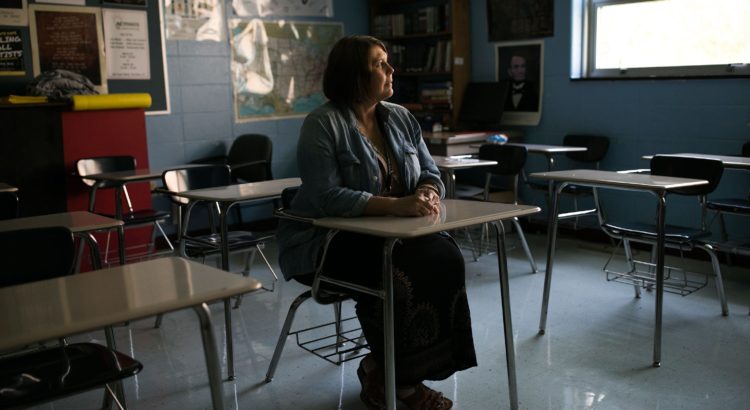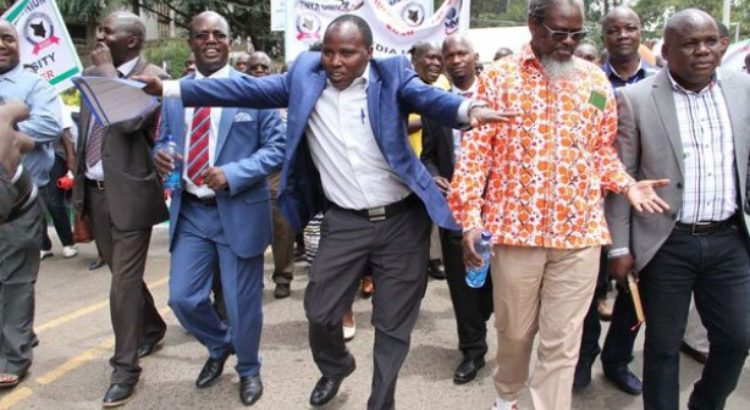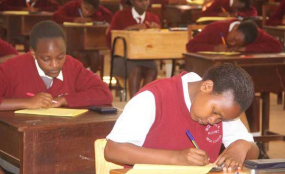United States / September 16, 2018 / Author: Katie Reilly / Source: Time
Hope Brown can make $60 donating plasma from her blood cells twice in one week, and a little more if she sells some of her clothes at a consignment store. It’s usually just enough to cover an electric bill or a car payment. This financial juggling is now a part of her everyday life—something she never expected almost two decades ago when she earned a master’s degree in secondary education and became a high school history teacher. Brown often works from 5 a.m. to 4 p.m. at her school in Versailles, Ky., then goes to a second job manning the metal detectors and wrangling rowdy guests at Lexington’s Rupp Arena to supplement her $55,000 annual salary. With her husband, she also runs a historical tour company for extra money.
“I truly love teaching,” says the 52-year-old. “But we are not paid for the work that we do.”
That has become the rallying cry of many of America’s public-school teachers, who have staged walkouts and marches on six state capitols this year. From Arizona to Oklahoma, in states blue, red and purple, teachers have risen up to demand increases in salaries, benefits and funding for public education. Their outrage has struck a chord, reviving a national debate over the role and value of teachers and the future of public education.

For many teachers, this year’s uprising is decades in the making. The country’s roughly 3.2 million full-time public-school teachers (kindergarten through high school) are experiencing some of the worst wage stagnation of any profession, earning less on average, in inflation-adjusted dollars, than they did in 1990, according to Department of Education (DOE) data.
Meanwhile, the pay gap between teachers and other comparably educated professionals is now the largest on record. In 1994, public-school teachers in the U.S. earned 1.8% less per week than comparable workers, according to the Economic Policy Institute (EPI), a left-leaning think tank. By last year, they made 18.7% less. The situation is particularly grim in states such as Oklahoma, where teachers’ inflation-adjusted salaries actually decreased by about $8,000 in the last decade, to an average of $45,245 in 2016, according to DOE data. In Arizona, teachers’ average inflation-adjusted annual wages are down $5,000.

The decline in education funding is not limited to salaries. Twenty-nine states were still spending less per student in 2015, adjusted for inflation, than they did before the Great Recession, according to the Center on Budget and Policy Priorities, leaving many public schools dilapidated, overcrowded and reliant on outdated textbooks and threadbare supplies.
To many teachers, these trends are a result of a decades-long and bipartisan war on public education, born of frustration with teachers’ unions, a desire to standardize curricula and a professed commitment to fiscal austerity. This has led to a widespread expansion of charter schools, which are publicly funded but privately operated, and actions such as a move in the Wisconsin legislature in 2011 to strip teachers’ pensions and roll back collective bargaining rights. This year, Colorado lawmakers voted to raise teachers’ retirement age and cut benefits.

As states tightened the reins on teacher benefits, many also enacted new benchmarks for student achievement, with corresponding standardized tests, curricula changes and evaluations of teacher performance. The loss of control over their classrooms combined with the direct hit to their pocketbooks was too much for many teachers to bear.
‘I love teaching. But we are not paid for the work that we do.’
– Hope Brown, Kentucky
The wave began in West Virginia, where in February and March some 20,000 teachers walked out across the state. Educators there—who made an average of $45,701 in 2016, according to the DOE—refused to enter their classrooms until the state met their demands to fully fund insurance benefits and increase salaries. Instead, they marched on the capitol, passed out bag lunches for low-income students who normally rely on free school meals and watched as public support flooded their way. After nine school days, lawmakers caved and approved a 5% wage increase. Weeks later, the specter of a similar strike led Oklahoma lawmakers to pass the state’s first major tax increase in nearly 30 years to fund raises for teachers who still walked out for more funding. Teachers in Kentucky and Arizona—both GOP-leaning states—followed their lead.
But teachers faced opposition at times from state and federal leaders. In April, Secretary of Education Betsy DeVos criticized striking teachers, suggesting they were failing to serve their students and urging them to “keep adult disagreements” out of the classroom.

And when school was out for the summer, the teachers’ momentum was blunted. In June, the Supreme Court ruled that public-sector unions can’t mandate fees from nonmembers—a decision that experts estimate could cost influential teachers’ unions money and clout. And in August, the Arizona supreme court blocked a ballot initiative that would have added $690 million annually to state education funding.
Teachers are out to regain the upper hand. Some have already gone on strike in Washington State, and others are threatening to do so in Los Angeles and Virginia. And they promise to turn out in force for November’s midterm elections, where hundreds of teachers are running for office on platforms that promise more support for public schools. They have also sought to remind the public that they are on the front lines of America’s frayed social safety net, dealing with children affected by the opioid crisis, living in poverty and fearful of the next school shooting.
Recent polling suggests teachers have the public on their side. Nearly 60% of people in a Ipsos/USA Today survey released Sept. 12 think teachers are underpaid, while a majority of both Republicans and Democrats believe they have the right to strike.
“We have to organize even harder and even broader,” says Los Angeles teacher Rosa Jimenez. “People are fired up.”

When Elaine Hutchison’s mother started teaching in Oklahoma in 1970, she made about $7,000 a year. In 2018 dollars, that’s roughly $45,000—nearly the same salary Hutchison, Oklahoma’s 2013 Teacher of the Year, now makes after a quarter-century on the job. Hutchison, 48, is a fourth-generation educator whose daughter also plans to become a teacher. She says she never got into teaching for the money, but, “I do want to be paid what I’m worth.”
Since the first U.S. public-school system was established in Massachusetts in 1647, many localities have struggled to pay teachers and searched for people willing to do the job for less. In the mid-1800s, California superintendent of public instruction John Swett lamented that the work of teachers was not “as well-paid as the brain labor of the lawyer, the physician, the clergyman, the editor.”
“They ought not to be expected to break mental bread to the children of others and feed their own with stones,” Swett wrote in 1865, foreshadowing arguments still made by teachers today.
‘We have to organize even harder and even broader.’
– Rosa Jimenez, California
Teaching has long been dominated by women, and experts say the roots of its relatively low pay lie in sexism. “The ‘hidden subsidy of public education’ is the fact that teachers for many years were necessarily working at suppressed wage levels because they really had no options other than teaching,” says Susan Moore Johnson, a professor of education at Harvard and an expert in teacher policy.
In 1960, teaching was more lucrative than other comparable careers for women, according to the EPI, but that was because of limited opportunity, not high pay. As women were admitted to other professions in wider numbers, choosing teaching carried a cost. For example registered nurses—another career historically dominated by women—make far more than teachers today, earning an average annual wage of $73,550 in 2017, according to the Bureau of Labor Statistics. Nursing shortages in some parts of the U.S. have led to signing bonuses, free housing, tuition reimbursement and other perks, while teacher shortages have contributed to some states increasing class sizes, shortening school weeks and enacting emergency certification for people who aren’t trained as educators.

Nationwide, the estimated average public-school teacher’s salary is now $58,950, according to the National Center for Education Statistics—a respectable income in many locales, but actual wages vary widely by state, and often do not track with costs of living. When compared to professions with similar education levels, teacher pay tends to pale. In 2016, for instance, the average teacher’s starting salary was $38,617—20% lower than that of other professions requiring a college degree.
The public response to the teachers’ protests shows signs of a shift in the perception of the profession. Even in conservative states, many voters backed tax increases to support public education, and called on lawmakers to stop cutting school budgets. State funding for public schools fell off a cliff 10 years ago, when recession-wracked states slashed education budgets and cut taxes. The uprising in West Virginia seemed to mark a turning point in public support for refilling the coffers.
Read more about what it’s like to survive on a teacher’s salary
But like most stories, the fight over teacher pay has many shades of gray. Generous retirement and health-benefits packages negotiated by teachers’ unions in flusher times are a drain on many states. Those who believe most teachers are fairly paid point to those benefits, along with their summer break, to make their case.
Teachers, however, say those apparent perks often disappear upon inspection. Many regularly work over the summer, planning curricula, taking continuing education and professional development courses, and running summer programs at their schools, making it a year-round job. Indeed, teachers—about 40% of whom are not covered by Social Security because of states’ reliance on pension plans—must stay in the same state to collect their pensions. Studies have shown that the majority of new teachers don’t stay in the same district long enough to qualify for pensions. Even for those who do stand to gain, it can be hard to find reassurance in distant retirement benefits when salaries haven’t kept pace with the cost of living.

“Utility companies do not care that you had a great day with one of your students. They don’t care that you’re coaching the soccer team. They want you to pay for the services that they provide you,” says NaShonda Cooke, a teacher and single mother of two in Raleigh, N.C. “I can’t tell you how many letters I got this summer that said final notice.” Cooke, who makes about $69,000, often skips doctor’s appointments to save the co-pay and worries about paying for her eldest daughter’s college education. “It’s not about wanting a pay raise or extra income,” she says. “It’s just about wanting a livable wage.”
Stagnant wages are one reason teachers believe school districts across the country are facing hiring crises. This year in Oklahoma, a record number of teachers were given emergency teaching certifications, despite no traditional training. In Arizona, school districts began recruiting overseas to fill their shortfall. Last year, U.S. public schools hired 2,800 foreign teachers on special visas, up from 1,500 in 2012, according to federal data.
‘I can’t tell you how many letters I got … that said “final notice.”’
-NaShonda Cooke, North Carolina
The pipeline, meanwhile, is drying up. Between 2008 and 2016, the number of new educators completing preparatory programs fell by 23%, according to the American Association of Colleges for Teacher Education. And once teachers make it to the classroom, attrition is high: at least 17% leave the profession within the first five years, a 2015 study found.
Hutchison says her daughter has plans to continue the family teaching tradition, but it’s becoming a harder path for a middle-class kid. Hutchison’s sibling—an attorney, engineer and physical therapist—all earned graduate degrees, but now she makes half of what they do. “My younger brother who’s an engineer—his bonus is more than my salary,” she says.

As the new school year gets under way, many are picking up where the spring protests left off. In L.A., teachers voted in August to authorize a strike if negotiations continue to stall over issues including teacher pay and class sizes. In Washington, teachers in several districts are already on strike, calling for pay raises to come out of newly allocated education funding. In Virginia, teachers are floating the possibility of a statewide walkout.
Brown, the Kentucky teacher, says the fight needs to happen now or never. If budget cuts and school privatization efforts continue, she warns, teaching will cease to be a viable career for educated, engaged and ambitious people. She talks about what she does not as a job but as a calling. “I’m not necessarily a religious person, but I do believe I was put here to be a teacher,” she says. “I just want to be able to financially do that.”
But to Brown, it’s not only about what she and her fellow teachers are worth, because they’re not in the classroom alone. If the public is on their side, they say, it’s ultimately because of the kids.
—With reporting by Haley Sweetland Edwards/New York
Source:
http://time.com/longform/teaching-in-america/?xid=time_socialflow_twitter&utm_medium=social&utm_source=twitter.com&utm_campaign=time
ove/mahv










 Users Today : 33
Users Today : 33 Total Users : 35460164
Total Users : 35460164 Views Today : 50
Views Today : 50 Total views : 3418833
Total views : 3418833